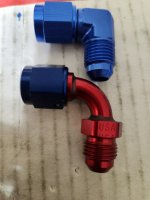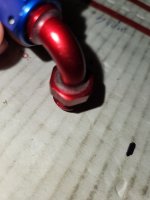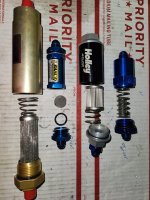Van's Air Force
You are using an out of date browser. It may not display this or other websites correctly.
You should upgrade or use an alternative browser.
You should upgrade or use an alternative browser.
Fuel filters
- Thread starter nohoflyer
- Start date
Where did you hear that?
Tom
Tom
Where did you hear that?
Tom
I think you told me this the other day when I was speaking to you (or possibly your partner) regarding removing the fairings.
I’m trying to access which is a better setup.
Roadjunkie1
Well Known Member
I’m trying to access which is a better setup.
I think the question should be where the fuel is coming from that you want to filter. If they are in the wing root, that is a filter for each tank. If it is beyond the fuel pump, that is one filter for both tanks.
On the rare occasion that something in one tank was caught in the filter and slowed the flow down, if you have them in the wing root, you can switch to the other (filtered) tank.
Either way the filters are accessible during inspection, be it condition or 100 hour.
Jetmart
Well Known Member
This makes servicing very easy. A little more than just a screen.
I have one in each wing root in a 14 which has lots of room.
https://www.kitplanes.com/clever-new-gascolator/
I have one in each wing root in a 14 which has lots of room.
https://www.kitplanes.com/clever-new-gascolator/
Richard Connell
Well Known Member
This makes servicing very easy. A little more than just a screen.
I have one in each wing root in a 14 which has lots of room.
https://www.kitplanes.com/clever-new-gascolator/
I have 2 of these under each front seat.
Awesome piece of kit. Highly recommend.
I just ordered the airflow performance fuel pump for a future IO-360 directly from TSflightlines. I see the the setup that vans sells includes the filter downstream the pump (which I have not ordered(yet)).
I guess vans advocates the downstream pump but I do see the advantage to catching the gunk pre pump and having one tank still able to feed.
I guess vans advocates the downstream pump but I do see the advantage to catching the gunk pre pump and having one tank still able to feed.
planenutz
Well Known Member
Filters
On injected engines it is desireable to have a filter prior to the electric high pressure fuel pump as these are generally more susceptable than the LP Pumps to damage from the variety of items that can make their way into the system. Placeing a filter on the inlet side will help ensure its longevity.
I have one of Francesca's filters (noted here as being available from Flyboys) and they are a perfect solution for most RV fuel systems. I really like the quality of this product and have one installed between my fuel selector and the HP Pump. I reckon you can't go wrong with one of these.
In respect to the OP's first question - yes, it is possible to remove the AFP Fliter from the assembly they sell you. I did exactly that and have placed this filter on the forward side of the firewall where it is easy to access and where any fuel drips are not going to end up in the cabin. Happy to share photos if you want them.
On injected engines it is desireable to have a filter prior to the electric high pressure fuel pump as these are generally more susceptable than the LP Pumps to damage from the variety of items that can make their way into the system. Placeing a filter on the inlet side will help ensure its longevity.
I have one of Francesca's filters (noted here as being available from Flyboys) and they are a perfect solution for most RV fuel systems. I really like the quality of this product and have one installed between my fuel selector and the HP Pump. I reckon you can't go wrong with one of these.
In respect to the OP's first question - yes, it is possible to remove the AFP Fliter from the assembly they sell you. I did exactly that and have placed this filter on the forward side of the firewall where it is easy to access and where any fuel drips are not going to end up in the cabin. Happy to share photos if you want them.
.....On injected engines it is desireable to have a filter prior to the electric high pressure fuel pump as these are generally more susceptable than the LP Pumps to damage from the variety of items that can make their way into the system. Placeing a filter on the inlet side will help ensure its longevity.....
Going to respectfully disagree, Sir. Both are positive displacement pumps so the working tolerances are very tight by their nature. Not uncommon (supplier specific) that the HP/LP pumps are the same construction but only have different relief valve (system pressure regulating) settings.
Verify the filtration requirements of the pump and meet that. Anything else is conjecture.
Edit = for clarity, talking upstream filters only as per the quote. Filters DS of the pumps should meet the requirements of the downstream system
Last edited:
Most have the filters before the pumps, whether is the AFP pump, the Andair pump, SDS, EFII or any other. Thats 'upstream". In the electronic systems, the SDS, or EFII, generally there is a 'post or downstream" filter to protect the injectors if the pump were to scatter debris forward.
Infomercial time----Our wing root filter (WRF) kits started from our friends in Canada that needed gascolators on the RV10s and 14s. Those planes originally didnt have a gascolator provision. There were a couple of root gascolator installs we helped with, including the Aerolabs unit, so that started the filter debate. Easier servicing, and potentially safer because its more accessible. We have since refined the installs, and have another revision pending.
Tom
Infomercial time----Our wing root filter (WRF) kits started from our friends in Canada that needed gascolators on the RV10s and 14s. Those planes originally didnt have a gascolator provision. There were a couple of root gascolator installs we helped with, including the Aerolabs unit, so that started the filter debate. Easier servicing, and potentially safer because its more accessible. We have since refined the installs, and have another revision pending.
Tom
Aircraft Specialty
Well Known Member
The Stock Setup on the VANS airplanes has a single filter upstream the pump. This is true whether the pump is AFP or Andair (in the case of the -14) It is a reliable and proven setup.
The wing root filters provide a set of filters that are also upstream of the pump. These were originally developed in conjunction with the SDS/EFII cabin fuel packages and then we transferred the design to the standard injection setups.
They are a fantastic option for those that are looking to be able to service filters outside the cabin versus inside the cabin of the aircraft.
We currently have wing root filter packages for the 10/14. As Tom alluded to, we are working on variations for a few additional aircraft. We have done some customized installs, but are working on install packages.
Happy building!
Steve
The wing root filters provide a set of filters that are also upstream of the pump. These were originally developed in conjunction with the SDS/EFII cabin fuel packages and then we transferred the design to the standard injection setups.
They are a fantastic option for those that are looking to be able to service filters outside the cabin versus inside the cabin of the aircraft.
We currently have wing root filter packages for the 10/14. As Tom alluded to, we are working on variations for a few additional aircraft. We have done some customized installs, but are working on install packages.
Happy building!
Steve
We get asked all the time about block style 90* adapters vs the bent tube versions. The bent versions are just slightly longer than their block style cousins, and probably could be made to the same drop lengths. While it is true that the bent tube version will 'probably' flow alittle better ( I just got these and havent tested them, but common sense says yes), I personally have a pet peve about them, especially in aluminum. The bent tube versions in the pics are from Earls, a very respected fitting supply company that I'm sure most of you have heard of.
They made their name in the racing game, from drag cars to Indy cars, so surely they would be fine on your experimental plane. My issue is the brazed joints between the ends and the tubes.
The dark colored area at the tops of the ends is the heated braze flux left over from the brazing process. The flex is generally mixed with the aluminum powder and spread at the joint, then heated by generally a 3 torch machine so the joint gets equal heat 360* around it. Its on a timer, and when the little bell goes ding (10-15 seconds) heat is removed, and coolant is sprayed on the joint. Yes, pretty strong, but I dont feel its as strong as the block style, with no brazing.
The machines take most of the experimentation of time and heat out of the equation. Back in my industrial days, we used acetylene and fluxed aluminum rods to make a/c fitting repair. Took LOTS of practice. Now is is less expensive to make the bent tube fittings, other than the labor involved, but you'll probably find they are more expensive, at least these examples were.
Eventually, I'll run a flow test on these for comparison. Might be a bit---got this OSHKOSH thing to attend.
Tom
They made their name in the racing game, from drag cars to Indy cars, so surely they would be fine on your experimental plane. My issue is the brazed joints between the ends and the tubes.
The dark colored area at the tops of the ends is the heated braze flux left over from the brazing process. The flex is generally mixed with the aluminum powder and spread at the joint, then heated by generally a 3 torch machine so the joint gets equal heat 360* around it. Its on a timer, and when the little bell goes ding (10-15 seconds) heat is removed, and coolant is sprayed on the joint. Yes, pretty strong, but I dont feel its as strong as the block style, with no brazing.
The machines take most of the experimentation of time and heat out of the equation. Back in my industrial days, we used acetylene and fluxed aluminum rods to make a/c fitting repair. Took LOTS of practice. Now is is less expensive to make the bent tube fittings, other than the labor involved, but you'll probably find they are more expensive, at least these examples were.
Eventually, I'll run a flow test on these for comparison. Might be a bit---got this OSHKOSH thing to attend.
Tom
Attachments
Re filters, are you guys using one that bypasses if clogged or do you consider it a non issue? I have root mounted filters but not yet flying.
Depending on which FI system you use, bypassing a clogged filter will just move the problem downstream in seconds. You might get away with it for a minute or two with a carb, assuming there is no additional filtering just before the inlet to the float bowl (don't have a carb, so not sure about that).
Happy to hear what the experts say, but I struggle to see a scenario that will be better with a fuel filter that bypasses when clogged.
Tommy, yes it does and has a full length stainless screen.
Pic shows 4 different filters and their elements. Bottom is the AirFlow Performance filter, 1090079-74 micron, Earls with disc screen, Holley 162-562 40 micron, and our filter, 40 micron, typically used in our wing root system along with the Holley filter.
The Earls would have been great, if it had a full length screen.
Tom
Pic shows 4 different filters and their elements. Bottom is the AirFlow Performance filter, 1090079-74 micron, Earls with disc screen, Holley 162-562 40 micron, and our filter, 40 micron, typically used in our wing root system along with the Holley filter.
The Earls would have been great, if it had a full length screen.
Tom
Depending on which FI system you use, bypassing a clogged filter will just move the problem downstream in seconds. You might get away with it for a minute or two with a carb, assuming there is no additional filtering just before the inlet to the float bowl (don't have a carb, so not sure about that).
Happy to hear what the experts say, but I struggle to see a scenario that will be better with a fuel filter that bypasses when clogged.
None of mine will bypass - my prepump tank filters get cleaned at annual, and my post-pump injector filter gets cleaned every hundred hours, every other oil change.
Roadjunkie1
Well Known Member
Depending on which FI system you use, bypassing a clogged filter will just move the problem downstream in seconds. You might get away with it for a minute or two with a carb, assuming there is no additional filtering just before the inlet to the float bowl (don't have a carb, so not sure about that.
Mickey: The typical setup for carburetors: a finger screen in the tank (relatively large screen holes; takes out the big junk); gascolator has a fine screen; carburetor has a fine-mesh finger screen at the fuel inlet. Wing root filters seem to be usually fine screen (30-50 microns is what I have seen...).







